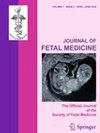在一个专业的双胞胎临床中,无并发症单绒毛膜双羊膜双胞胎与双绒毛膜双羊膜双胞胎围产期结局的比较研究——一项前瞻性研究
IF 0.2
Q4 OBSTETRICS & GYNECOLOGY
引用次数: 0
摘要
背景单绒毛膜双胞胎的围产期发病率和死亡率高于双绒毛膜双胞胎。然而,关于无并发症的单绒毛膜双胞胎的结果有相互矛盾的数据。研究目的本研究的目的是比较单绒毛膜双胞胎和双绒毛膜双胞胎的结果。方法前瞻性研究于2019年8月至2020年12月在一家专业双胞胎诊所进行。所有的双胞胎,其绒毛膜性在14周前被确定,24周时有两个活胎,被招募。排除伴有双胎输血综合征、双胎贫血多红细胞血症综合征、24周前选择性胎儿生长受限和24周前单胎或双胎死亡的复杂单绒毛膜双胎(MCDA)双胞胎。其他排除标准包括先天性和染色体异常、高序胎、单羊膜双胞胎和产前绒毛膜性不确定的双胞胎。两组均随访至分娩,新生儿随访至28 d。研究并比较了产妇和新生儿的结局。结果148例双绒毛膜双羊膜血症(DCDA)和74例无并发症双绒毛膜双羊膜血症(MCDA)。两组平均胎龄均为35周。除了DCDA组的早发性子痫前期较高外,两组的母体、胎儿和新生儿发病率相似。24周后DCDA和MCDA的死胎预期风险分别为1.35%和4.05%。30周后DCDA和MCDA的死产预期风险分别为1.49%和0%。结论无并发症的MCDA双生儿的母婴结局与DCDA双生儿相似。30周后死产的预期风险极低。因此,无并发症的MCDA双胞胎不应在36周前选择性分娩。本文章由计算机程序翻译,如有差异,请以英文原文为准。
Comparative Study of Perinatal Outcome in Uncomplicated Monochorionic Diamniotic versus Dichorionic Diamniotic Twins at a Specialized Twin Clinic—A Prospective Study
Abstract Background Monochorionic twins have higher perinatal morbidity and mortality than dichorionic twins. However, there is conflicting data on outcomes of uncomplicated monochorionic twins. Purpose of the Study The aim of this study is to compare the outcomes of apparently uncomplicated monochorionic twins to dichorionic twins. Methods This is a prospective study conducted from August 2019 to December 2020 at a specialized twin clinic. All twins, whose chorionicity was determined before 14 weeks with two live fetuses at 24 weeks, were recruited. Complicated monochorionic diamniotic (MCDA) twins with twin-to-twin transfusion syndrome, twin anemia polycythemia syndrome, selective fetal growth restriction before 24 weeks and single or double fetal demise before 24 weeks were excluded. Other exclusion criteria were major congenital and chromosomal abnormalities, higher order multiples, monoamniotic twins, and twins with undetermined chorionicity antenatally. Both the groups were followed till delivery and neonates followed till 28 days. Maternal and neonatal outcomes were studied and compared. Results One-hundred forty-eight mothers with dichorionic diamniotic (DCDA) and 74 with uncomplicated MCDA were studied. Mean gestational age at delivery was 35 weeks in both the groups. Maternal, fetal, and neonatal morbidities were similar in both, except early onset preeclampsia that was higher in the DCDA group. Prospective risk of stillbirth for DCDA and MCDA after 24 weeks was 1.35 and 4.05%, respectively. Prospective risk of stillbirth for DCDA and MCDA after 30 weeks was 1.49 and 0%, respectively. Conclusion The maternal and perinatal outcomes in uncomplicated MCDA twins are similar to DCDA twins. Prospective risk of stillbirth after 30 weeks is extremely low. Hence, uncomplicated MCDA twins should not be delivered electively before 36 weeks.
求助全文
通过发布文献求助,成功后即可免费获取论文全文。
去求助
来源期刊

Journal of Fetal Medicine
OBSTETRICS & GYNECOLOGY-
自引率
50.00%
发文量
26
期刊介绍:
Journal of Fetal Medicine is the official journal of the Society of Fetal Medicine affiliated with International Society of Ultrasound in Obstetrics & Gynecology. This is a peer-reviewed international journal featuring articles with special interest to fetal medicine specialists, geneticists and ulstrasonologists. The aim of the journal is to communicate the results of original research in the field of fetal medicine. It includes a variety of articles suitable for clinicians and scientific specialists concerned with diagnosis and therapy of fetal disorders. All articles on health promotion of the fetus are acceptable for publication. The major focus is on highlighting the work that has been carried out in India and other developing countries. It also includes articles written by experts from the West. Types of articles published: - Original research articles related to fetal care and basic research - Review articles - Consensus guidelines for diagnosis and treatment - Case reports - Images in Fetal Medicine - Brief communications
 求助内容:
求助内容: 应助结果提醒方式:
应助结果提醒方式:


